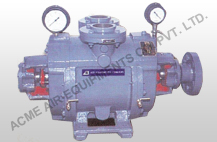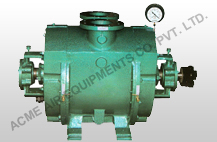Table of Contents
Liquid ring vacuum pumps work by using compression to move sealant and impeller cells toward the discharge port. The compression is then released into the atmosphere. Most liquid ring vacuum pumps are powered by induction motors and their impellers are friction-free. The shaft seals also prevent sliding friction. The rotor is the only moving part of a liquid ring vacuum pump.
Mechanics of Liquid Ring Vacuum Pump
The liquid ring vacuum pump is a type of vacuum pump with a ring-shaped chamber. Its design makes it suitable for use in a variety of industries, including chemical, petrochemical, and pharmaceutical. Its advantages include the ability to handle a wide range of media, including highly explosive gases. This type of pump also features an insulated housing to protect it from damage during an explosion.
A liquid ring vacuum pump operates by using an impeller with blades and vanes. The impeller is driven by an induction motor and features an offset design. This means that the blades are located closest to the outside of the pump body and farther from the bottom.
The discharge port is located downstream of the pump in a closed circuit. When the pump is not in use, the newly pressurized gas is released through the discharge port, 90 degrees away from the inlet port. The pump can be equipped with isolation valves, but butterfly valves are considered more efficient.
The liquid ring vacuum pump uses two simple principles to create vacuum. First, it traps gas inside the moving part, while the second stage stops it by using a liquid seal. Second, the liquid ring vacuum pump is also capable of cooling and condensing the gas it conveys. The pump has many uses. For example, it can be used to create a rough vacuum in the chemical industry.

Functions of Liquid Ring Vacuum Pump
A liquid ring vacuum pump is designed to handle a large amount of liquid through its inlet port. The liquid is then exhausted by the pump’s discharge port to a level of atmospheric pressure or even higher. Although some liquid will escape with the gasses, some will remain in the pump and need to be replenished.
The performance parameters of a liquid ring pump can be predicted by using its major geometric parameters. The primary parameters to be considered include the shaft power, axial width of the impeller, and liquid friction loss. These can be calculated using a measurement device. However, the theoretical results are not necessarily accurate, and more advanced models should be used when predicting performance.
A liquid ring vacuum pump has many uses in the chemical, petrochemical, pharmaceutical, and construction industries. They are also used in the manufacture of paints and colors. They can also be used in mechanical engineering. The design of these pumps makes them ideal for potentially explosive environments, and they are suitable for a wide range of industrial processes.
Most liquid ring vacuum pumps have a friction-free impeller. The shaft seals prevent sliding friction between the impeller and the sealant, which is pumped away. The liquid ring also draws gasses and vapours from the inlet port, which causes suction.
The liquid ring vacuum pump is designed to operate in a cycle of suction-compression-discharge-expansion. Various performance tests have proven this theory. A universal theoretical model has been developed for the pump, and the results have been validated through experiments. Moreover, the expansion process of the residual gas is near an adiabatic process, resulting in a shorter expansion time and shorter expansion path.
Inlet and Discharge Ports in Liquid Ring Vacuum Pump
A liquid ring vacuum pump is a type of vacuum pump that is used to extract air and liquid. The pump is a two-stage design with two different inlet and discharge ports. The first stage is used for the initial pressure boosting and the second stage is used to achieve higher pressure levels and discharge them to the atmosphere.
The principle behind liquid ring pumps is quite simple. The fluid is fed into the pump via the inlet port and is thrown out by centrifugal force through the discharge port. The liquid and gas travels around the air pocket in the center to be compressed and ejected.
Liquid ring vacuum pumps are versatile and can be used for a wide range of applications. Besides using them for compression and vacuum jobs, they are also used in the aircraft industry for testing carburettor’s and performing altitude chamber work. In addition to these applications, these pumps are used for a variety of tasks, such as holding and aerating parts.

Rotating Liquid Ring Vacuum Pump
Rotating liquid ring vacuum pumps operate on the principle of centrifugal force and recirculation. Fluid is fed into the pump through the inlet port and is thrown outside the cylinder by centrifugal force. Gas, on the other hand, travels around the void in the center of the pump. The compressed gas is then fed out of the discharge port.
A rotating liquid ring vacuum pump is a simple design that compresses air or other gas by rotating a vaned impeller. The rotating impeller contains an elongated liquid ring that forms a series of seals in the space between the impeller’s vanes. Because the impeller is eccentric, the volume of the gas that passes through the pump varies cyclically.
A liquid ring vacuum pump can be a single-stage or a multi-stage unit. A multistage pump typically has two compression stages on a common shaft. However, the pressure reduction is limited by the amount of liquid vapor generated by the ring-liquid. The increasing volume of liquid vapor reduces the vacuum capacity, which decreases efficiency.
A rotating liquid ring vacuum pump can have a single or multiple apertures. One of the main differences between this type and a conventional rotary pump is that the rotating ring can contain more than one liquid at a time. A single ring can contain several thousand liters of liquid. This type of pump can be used in lab environments and hospitals.
A liquid ring vacuum pump is an efficient solution for removing wet gases from industrial systems. Developed at the turn of the twentieth century, liquid ring technology has become a staple product. These pumps are easy to operate, have only one moving part, and require minimal maintenance. Furthermore, the liquid ring vacuum pump is durable and does not require oil changes or oil-pans.
Cooling Water System in Liquid Ring Vacuum Pump
A Liquid Ring Vacuum Pump is a mechanical device that pumps a liquid through a cooling water system. It has an off-set impeller with blades that are located closer to the outer wall of the pump. This relative eccentricity causes the liquid to compress and ring around the outer wall of the pump.
Liquid ring pumps are available in single and multistage varieties. Multistage systems generally have two compression stages that are arranged on a common shaft. The amount of liquid that can be compressed by a single stage pump is limited by its vapor pressure at operating temperatures. This limits the amount of vacuum that can be achieved.
The pump is equipped with a liquid separator located downstream from the pump. This separator helps the pump save up to 95 percent of the operating fluid. It is also used in systems that have high suction pressures. This prevents the operating fluid from being diluted due to pressure drop in the piping system. A heat exchanger is also included to help with the cooling process by lowering the heat produced by the seal liquid.
Liquid Ring Vacuum Pumps are a type of pump that is commonly used in cooling water systems. These pumps are designed to remove dissolved gases from the cooling water. Dissolved gases can build up in a cooling water system, making it hard for it to perform its function.
A Liquid Ring Vacuum Pump is a mechanical pump that relies on a liquid seal to create a vacuum. The liquid that fills the pump is then cooled in a separate separator vessel and then reintroduced into the pump. The cooled liquid removes the heat produced during operation.
The Bottom Line
A liquid ring vacuum pump is very reliable, and it can last for many years. Liquid ring pumps come in both small and large sizes. A small model can be placed directly on the floor, while a large one must be installed on a concrete pad. Before installing a liquid ring vacuum pump, be sure to inspect the internal piping and ensure there are no stress joints. Even if the parts are factory tested, they can still be subject to stress during shipping.
o



